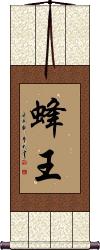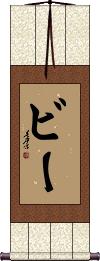Many custom options...
And formats...

Insect in Chinese / Japanese...
Buy an Insect calligraphy wall scroll here!
Personalize your custom “Insect” project by clicking the button next to your favorite “Insect” title below...
Queen Bee
Queen Bee
Scorpion
蠆 is a very ancient Chinese word meaning scorpion.
This can also mean insect depending on the context. 蠆 is a very old character, so modern Chinese people might not recognize it immediately.
Northern Praying Mantis
This can be translated literally as “Praying Mantis Fist.”
螳螂拳 is sometimes called Shandong Praying Mantis after its place of origin. It was created by Wang Lang and was named after the praying mantis, an insect, the aggressiveness of which inspired the style.
Shaolin records document that Wang Lang was one of the 18 masters gathered by the Shaolin Abbot Fu Ju, which dates him and Northern Praying Mantis style to the Song Dynasty (960-1279 A.D.).
The fact that the word “Northern” is used in the English title has more to do with where this style came from (Shandong is in northern China), but “north” is absent from this Chinese title.
Note: 螳螂拳 is also a title in Japanese - however, only a Japanese person who practices or is familiar with the “Praying Mantis Fist” style would recognize it.
Not the results for insect that you were looking for?
Below are some entries from our dictionary that may match your insect search...
| Characters If shown, 2nd row is Simp. Chinese |
Pronunciation Romanization |
Simple Dictionary Definition |
蠆 虿 see styles |
chài chai4 ch`ai chai |
More info & calligraphy: Scorpion |
翅 see styles |
chì chi4 ch`ih chih hane はね |
(bound form) wing (of a bird or insect) (See 羽・はね・2) wing (of an insect); (surname) Tsubasa A wing, fin; translit. ke. |
芸 see styles |
yún yun2 yün nori のり |
common rue (Ruta graveolens); (used in old compounds relating to books because in former times rue was used to protect books from insect damage) art; craft; accomplishment; artistic skill; technique; performance; (personal name) Nori |
虫 see styles |
chóng chong2 ch`ung chung mushi むし |
variant of 蟲|虫[chong2] (1) insect; bug; cricket; moth; (2) worm; roundworm; (3) (See 虫を殺す・むしをころす) one's emotions; one's feelings; (4) (See 虫気・むしけ) nervousness; fretfulness; (5) (See 本の虫・ほんのむし) person devoted to one thing; single-minded person; (6) valve core; (personal name) Mushi Insect, reptile; any creeping thing; animal, man as of the animal kingdom. |
蚋 see styles |
ruì rui4 jui buyo ぶよ buyu ぶゆ buto ぶと |
(mosquito); Simulia lugubris; blackfly (kana only) black fly (any insect of family Simuliidae); gnat |
蚛 see styles |
zhòng zhong4 chung |
(literary) (of a worm or insect) to nibble; to bite; worm-eaten |
蚽 see styles |
pí pi2 p`i pi |
a kind of insect (old) |
蛩 see styles |
qióng qiong2 ch`iung chiung koorogi こおろぎ |
anxious; grasshopper; a cricket (out-dated kanji) (1) (kana only) cricket (Gryllidae spp.); (2) (archaism) any insect that chirps in autumn |
蛬 see styles |
koorogi こおろぎ |
(out-dated kanji) (1) (kana only) cricket (Gryllidae spp.); (2) (archaism) any insect that chirps in autumn |
蛻 蜕 see styles |
tuì tui4 t`ui tui monuke もぬけ nukegara ぬけがら |
skin cast off during molting; exuvia; to pupate; to molt; to slough; to cast off an old skin or shell shed skin of snake, insect, etc. (also place left behind); cast-off skin (snake, insect, etc.); husk; empty shell; exuvia; exuviae |
蝮 see styles |
fù fu4 fu mamushi; mamushi; hami(ok); kuchibami(ok); tajihi(ok) マムシ; まむし; はみ(ok); くちばみ(ok); たじひ(ok) |
insect; poisonous snake (archaic) (kana only) (See クサリヘビ) pit viper (esp. the mamushi, Gloydius blomhoffi) |
螟 see styles |
míng ming2 ming |
boring insect; snout moth's larva (Aphomia gullaris or Plodia interpuncuella or Heliothus armigera etc), major agricultural pest |
蟆 see styles |
má ma2 ma buto ぶと hiki ひき |
toad (kana only) black fly (any insect of family Simuliidae); gnat; (kana only) toad (esp. the Japanese toad, Bufo japonicus) |
蟜 see styles |
jiǎo jiao3 chiao |
(insect) |
蟲 虫 see styles |
chóng chong2 ch`ung chung jū |
lower form of animal life, including insects, insect larvae, worms and similar creatures; CL:條|条[tiao2],隻|只[zhi1]; (fig.) person with a particular undesirable characteristic The animal kingdom including man, but generally applied to worms, snails, insects, etc.; also 蟲 6 q. v. |
蟿 see styles |
qì qi4 ch`i chi |
(insect); Tryxalis masuta |
蠁 蚃 see styles |
xiǎng xiang3 hsiang |
(literary) insect larva; Taiwan pr. [xiang4] |
蠡 see styles |
lǐ li3 li rei |
wood-boring insect gourd |
蠱 蛊 see styles |
gǔ gu3 ku maji まじ |
arch. legendary venomous insect; to poison; to bewitch; to drive to insanity; to harm by witchcraft; intestinal parasite (1) (archaism) (See 蠱物) charmed and cursed; (2) something that bewilders; something that leads one astray; the work of demons spell |
蠹 see styles |
dù du4 tu |
insect that eats into books, clothing etc; moth-eaten; worm-eaten |
鬚 须 see styles |
xū xu1 hsü hige ひげ |
beard; mustache; feeler (of an insect etc); tassel (1) (kana only) moustache; beard; whiskers; (2) extremely short pulse appearing on an electrical signal beard |
七節 see styles |
nanafushi ななふし |
(kana only) walking stick (any insect of order Phasmatodea); walkingstick; stick insect; leaf insect |
促織 促织 see styles |
cù zhī cu4 zhi1 ts`u chih tsu chih |
cricket (insect) |
候蟲 候虫 see styles |
hòu chóng hou4 chong2 hou ch`ung hou chung |
seasonal insect (e.g. cicada) |
初鳴 see styles |
hatsunaki はつなき |
(irregular okurigana usage) first song or chirp, etc. (in the year) of a particular bird or insect species |
前翅 see styles |
qián chì qian2 chi4 ch`ien ch`ih chien chih zenshi ぜんし |
front wing (of insect) fore-wing (of insect) |
口器 see styles |
kǒu qì kou3 qi4 k`ou ch`i kou chi kouki / koki こうき |
mouthparts (of animal or insect) trophi (mouthparts of an insect, etc.) |
叮咬 see styles |
dīng yǎo ding1 yao3 ting yao |
sting; bite (of insect) |
合攏 合拢 see styles |
hé lǒng he2 long3 ho lung |
to close (flower, eyes, suitcase etc); to bring together; (insect or bird when not flying) to fold (its wings) |
吊虻 see styles |
tsuriabu つりあぶ |
(kana only) bee fly (any insect of family Bombyliidae) |
Click here for more insect results from our dictionary
The following table may be helpful for those studying Chinese or Japanese...
| Title | Characters | Romaji (Romanized Japanese) | Various forms of Romanized Chinese | |
| Queen Bee | 蜂王 | fēng wáng feng1 wang2 feng wang fengwang | ||
| Queen Bee | 女王蜂 | jooubachi / jobachi | ||
| Bee | ビー | bii / bi | ||
| Scorpion | 蠆 虿 | chài / chai4 / chai | ch`ai / chai | |
| Bee | 碧 | bì / bi4 / bi | pi | |
| Northern Praying Mantis | 螳螂拳 | tou rou ken tourouken to ro ken | táng láng quán tang2 lang2 quan2 tang lang quan tanglangquan | t`ang lang ch`üan tanglangchüan tang lang chüan |
| In some entries above you will see that characters have different versions above and below a line. In these cases, the characters above the line are Traditional Chinese, while the ones below are Simplified Chinese. | ||||
Successful Chinese Character and Japanese Kanji calligraphy searches within the last few hours...









